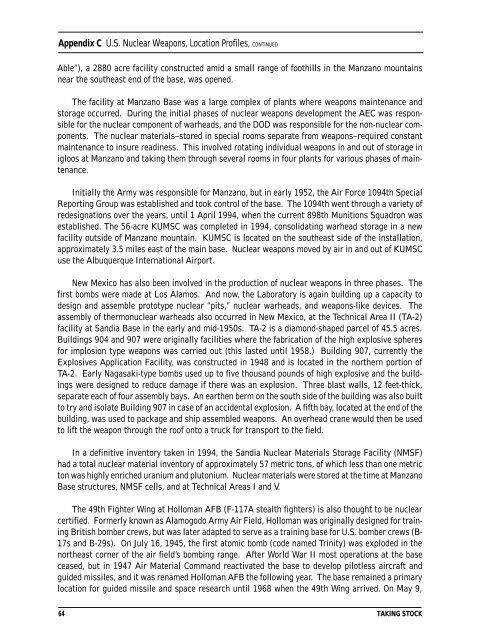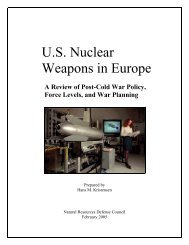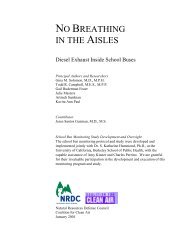p.53-94 (pdf) - Natural Resources Defense Council
p.53-94 (pdf) - Natural Resources Defense Council
p.53-94 (pdf) - Natural Resources Defense Council
You also want an ePaper? Increase the reach of your titles
YUMPU automatically turns print PDFs into web optimized ePapers that Google loves.
Appendix C U.S. Nuclear Weapons, Location Profiles, CONTINUED<br />
Able”), a 2880 acre facility constructed amid a small range of foothills in the Manzano mountains<br />
near the southeast end of the base, was opened.<br />
The facility at Manzano Base was a large complex of plants where weapons maintenance and<br />
storage occurred. During the initial phases of nuclear weapons development the AEC was responsible<br />
for the nuclear component of warheads, and the DOD was responsible for the non-nuclear components.<br />
The nuclear materials–stored in special rooms separate from weapons–required constant<br />
maintenance to insure readiness. This involved rotating individual weapons in and out of storage in<br />
igloos at Manzano and taking them through several rooms in four plants for various phases of maintenance.<br />
Initially the Army was responsible for Manzano, but in early 1952, the Air Force 10<strong>94</strong>th Special<br />
Reporting Group was established and took control of the base. The 10<strong>94</strong>th went through a variety of<br />
redesignations over the years, until 1 April 19<strong>94</strong>, when the current 898th Munitions Squadron was<br />
established. The 56-acre KUMSC was completed in 19<strong>94</strong>, consolidating warhead storage in a new<br />
facility outside of Manzano mountain. KUMSC is located on the southeast side of the installation,<br />
approximately 3.5 miles east of the main base. Nuclear weapons moved by air in and out of KUMSC<br />
use the Albuquerque International Airport.<br />
New Mexico has also been involved in the production of nuclear weapons in three phases. The<br />
first bombs were made at Los Alamos. And now, the Laboratory is again building up a capacity to<br />
design and assemble prototype nuclear “pits,” nuclear warheads, and weapons-like devices. The<br />
assembly of thermonuclear warheads also occurred in New Mexico, at the Technical Area II (TA-2)<br />
facility at Sandia Base in the early and mid-1950s. TA-2 is a diamond-shaped parcel of 45.5 acres.<br />
Buildings 904 and 907 were originally facilities where the fabrication of the high explosive spheres<br />
for implosion type weapons was carried out (this lasted until 1958.) Building 907, currently the<br />
Explosives Application Facility, was constructed in 1<strong>94</strong>8 and is located in the northern portion of<br />
TA-2. Early Nagasaki-type bombs used up to five thousand pounds of high explosive and the buildings<br />
were designed to reduce damage if there was an explosion. Three blast walls, 12 feet-thick,<br />
separate each of four assembly bays. An earthen berm on the south side of the building was also built<br />
to try and isolate Building 907 in case of an accidental explosion. A fifth bay, located at the end of the<br />
building, was used to package and ship assembled weapons. An overhead crane would then be used<br />
to lift the weapon through the roof onto a truck for transport to the field.<br />
In a definitive inventory taken in 19<strong>94</strong>, the Sandia Nuclear Materials Storage Facility (NMSF)<br />
had a total nuclear material inventory of approximately 57 metric tons, of which less than one metric<br />
ton was highly enriched uranium and plutonium. Nuclear materials were stored at the time at Manzano<br />
Base structures, NMSF cells, and at Technical Areas I and V.<br />
The 49th Fighter Wing at Holloman AFB (F-117A stealth fighters) is also thought to be nuclear<br />
certified. Formerly known as Alamogodo Army Air Field, Holloman was originally designed for training<br />
British bomber crews, but was later adapted to serve as a training base for U.S. bomber crews (B-<br />
17s and B-29s). On July 16, 1<strong>94</strong>5, the first atomic bomb (code named Trinity) was exploded in the<br />
northeast corner of the air field’s bombing range. After World War II most operations at the base<br />
ceased, but in 1<strong>94</strong>7 Air Material Command reactivated the base to develop pilotless aircraft and<br />
guided missiles, and it was renamed Holloman AFB the following year. The base remained a primary<br />
location for guided missile and space research until 1968 when the 49th Wing arrived. On May 9,<br />
64 TAKING STOCK
















